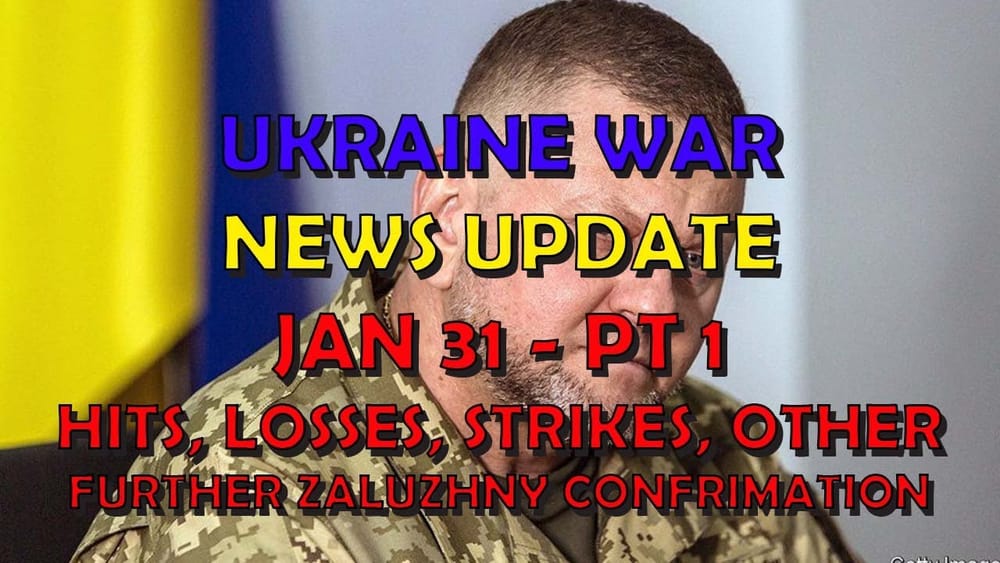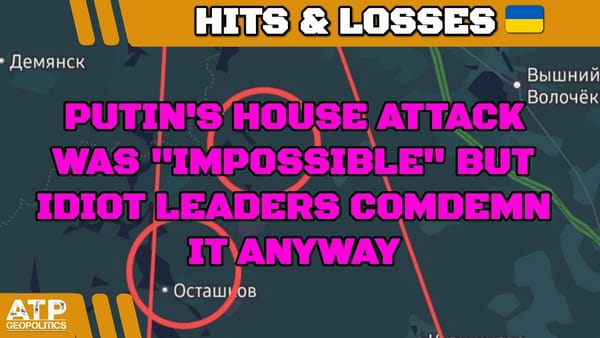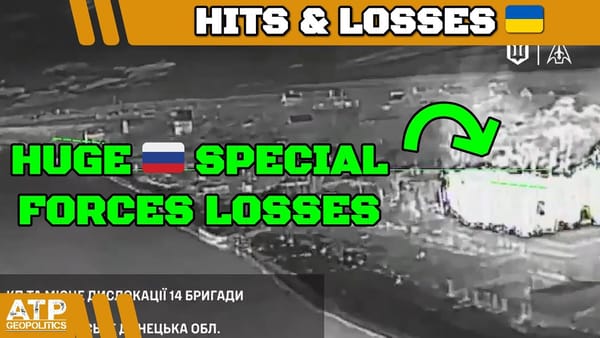Ukraine War Update NEWS: Pt 1 - Overnight & Other News, Zaluzhny News
Table of Contents 📖
"Russia is nothing, nothing but bombs and lies"
Hello Team
🎦 00:00-00:57⏩
Jonathan starts the update by explaining that he's "feeling rough as a badger's arse" as he's unwell. He explains that this is amplified by his primary progressive multiple sclerosis, especially affecting his mobility more than usual. He reads out a kind comment from a viewer, "although we differ in our view of this war I believe you're a good bloke". Jonathan thanks the viewer and jokes that he is "ageing terribly"!
Return to top⤴️
🪦 DISCLAIMER FOR GENERAL STAFF LOSSES DATA
- These are real people with real lives and real families who love them. Don’t let the numbers sap your humanity.
- These numbers probably aren’t accurate but they’re the best we have and we don’t need them to be accurate to be indicative of patterns of activity.
- All losses are estimates. Losses cannot be counted with accuracy because of the conditions on the ground.
- Both sides would see it to be of their advantage to minimize their own losses maximize the other side’s losses.
- Neither side releases their losses but we have enough transparency from the Ukrainian side to have confidence in they are indicative.
- Personnel losses are hard to count. If a soldier gets injured, heals up, and returns to the front line only to get injured again, is that one loss or two? Also, how to deal with losses from PMC’s or soldiers fighting with RF from occupied territories?
- Equipment losses are hard to count. If an AA complex involves several parts and one part gets disabled, is that a loss, or a fraction of a loss? If a tank gets disabled, repaired, back into the fight, then disabled again, is that one lost tank or two?
- All recorded losses are vulnerable to multiple reporting. We have already seen numerous cases of multiple drones in the air reporting the same loss from different angles as multiple engagements.
- Losses are not always reported on the same day they occurred. It is frequent that drone losses are reported at least 24 hours after other terrestrial equipment losses. Certain losses may not be reported for days or weeks for military intelligence reasons.
Ukraine General Staff Report - High Russian Losses
🎦 00:57-03:34⏩
Jonathan reviews the Ukrainian General Staff figures for Russian losses for the previous day and notes these are "phenomenally high figures again today".
- Personnel losses are over 1000 (1090 to be precise) which is described as "a very high number" and that "things are pretty active in a number of places".
- 10 tanks - "pretty decent"
- 32 armoured personnel vehicles - "certainly a high number" which Jonathan suggests means the Russians are attacking.
- 51 artillery systems - "a very high number there's no doubt about that" and "a bad day of losses for the Russians".
- 2 multiple launch rocket systems.
- 40 vehicles and fuel tanks - "significant"
- 4 pieces of special equipment.
Jonathan questions how verifiable the figures are, but states that "even if you took 30% off" the figures are "still incredibly high". He then compares the figures with visually confirmed losses compiled by Oryx, noting that there's a "five or six to one loss ratio, Russian to Ukrainian losses".
Return to top⤴️
Analysis of Visually Confirmed Equipment Losses (Oryx)
🎦 04:22-06:57⏩
Jonathan analyses the latest visually confirmed equipment losses using Oryx data, crediting Andrew Perpetua for compiling the data. He notes that:
- There are more destroyed/abandoned Russian equipment than damaged which he considers to be significant.
- 2 boats destroyed - suggesting Ukrainian activity on the Dnipro River.
- Unidentified tanks destroyed, which, he reasons, must be because they are significantly burnt out.
- A "huge number of infantry fighting vehicles".
- "A mass of Russian equipment lost" with a "huge ratio of Russian losses to Ukrainian losses".
Jonathan states that whilst this "very much suits the Ukrainians" it also "leads us to believe that these figures are at least somewhat correct". He does however question the high numbers of reported artillery system losses, pointing out that these don't always seem to be reflected in the Oryx data.
Return to top⤴️
Effectiveness of Ukrainian Drone Warfare Tactics
🎦 06:57-17:12⏩
Jonathan cites a report by WarTranslated which in turn refers to a post by Russian military reporter 'Dvar' who states that "Ukrainian drone work has become" very effective. This follows a claim that 19 FPV drones were used to target a single Russian assault squad after they took up position in a building. Jonathan describes this as "an incredible capability of the Ukrainians" and "an incredible um capability". Jonathan highlights the logistical challenges in co-ordinating this type of attack. He suggests that drones are being used as an alternative to artillery, which would likely have been used in this scenario in the past, and that it is "arguably cheaper than sending in artillery". The reporter goes on to claim that in "one direction" the enemy had 19 drone operators on standby and in another "Ukrainian armed forces drones buzz in the sky around the clock". The Russian reporter also states that the Ukrainians are using "Baba Yaga" octocopter drones to drop multiple drones and as repeaters "to add another 10km to the range" Jonathan speculates that this could explain why artillery, which is typically positioned further away from the frontlines (outside of drone range), is being hit by drones - they are being targeted by FPV drones launched from Baba Yaga drones, and therefore within range. He also notes an increase in air battles, not just with Baba Yagas, but with other drones, as a consequence of the volume of drones in contested airspace. Jonathan highlights an account by a Russian reporter, Filatov, who describes how a Russian 'Altair' drone rammed a Ukrainian Baba Yaga drone carrying "heavy bombs that can destroy a building". He speculates that the reluctance of the Russians to use a second Altair drone to take out a second Baba Yaga suggests that they may not have sufficient numbers of this type of drone to risk losing more. The reporter adds that they are "constantly trying to come up with something to combat this crap" - referring to the Baba Yaga drones - which Jonathan observes are clearly a nuisance for the Russians who are struggling to counter them. Jonathan also refers to an incident in which a Lancet drone, targeting a German-supplied Panzerhaubitze 2000 self-propelled howitzer, detonated too early "making a penetration impossible" due to being equipped with a new LIDAR warhead. Jonathan highlights that, according to the Lancet wiki page, there is no mention of a LIDAR warhead. He explains that LIDAR, which is similar to RADAR but uses laser or infra-red light, enables the drone to measure distances very accurately and to detonate its explosive charge from a safe distance to ensure maximum penetration - similar to a Javelin missile. Jonathan then shows footage of that attack and notes that whilst the footage is of low resolution, it clearly shows the Lancet drone exploding on the road some distance away from the Panzerhaubitze 2000, and speculates that the premature explosion was about 10 metres too early.
Return to top⤴️
Strikes in Russia
🎦 20:55-25:59⏩
Jonathan reports a number of strikes inside Russia, starting with a fire which destroyed a "shoe warehouse" in the Vladimir region of Russia. This is followed by reports of a blast and smoke at a thermal power plant in Moscow (attributed by the Russians to another short circuit) which resulted in power outages in the city. Jonathan then reports that 14 out of 20 'Shahed' drones were shot down overnight. He highlights that, whilst this is a better interception rate than the previous night, the remaining 6 drones "will be finding their targets" and causing problems. He goes on to highlight a number of other incidents:
- A fire in a residential area in Kharkiv, possibly caused by a drone being shot down, or as a result of a strike.
- A drone shot down over Belgorod Oblast in Russia (no casualties reported).
- Explosions in St Petersburg (which could be heard across the city), thought to be as a result of drone attacks.
Footage is shown of a large explosion in St Petersburg and it is reported that a drone struck the 'Nevsky Mazut' oil refinery causing a fire. This is followed by an account by WarTranslated which refers to an "unidentified flying object" which "landed bang in the middle of the city" at the 'Nevsky Mazut' plant. It is reported that St Petersburg authorities had been testing disabling GPS signals in the city to prevent drone attacks and this is thought to be linked to an upcoming visit to the city by Putin. Jonathan observes that despite their attempts to jam the signals, the attacks on energy and power infrastructure are continuing.
Return to top⤴️
Russia's Internet Down: Possible implications for Online Propaganda
🎦 25:59-30:38⏩
Jonathan reports that large parts of Russia's internet is down. He cites a report from United24 which claims that residents across Russia are reporting outages for .ru domains, and that government services are unavailable. There are also reports of problems with bank cards and online orders. He goes on to report an explosion at an electrical substation in the Moscow region which Russian authorities are claiming was a malfunction, adding that this is "another sign of how Russian infrastructure is crumbling". He notes that similar incidents had been reported in Chelyabinsk and in dozens of locations across Russia "in quantities not seen since the Soviet Union". Jonathan speculates that the internet outage, coupled with reports that Ukrainian intelligence have targeted the servers of the Russian Ministry of Defence, could be linked to a reduction in online troll and bot activity on social media. He cites a tweet from 'Trentolenko' which states that the attacks on Moscow's power plants "makes a lot of sense now, given where those troll farms are located". This is followed by an observation from a commenter, 'JNK in Kiev', who asks why "approximately 20% of all social media posts now [are] originating from Russian troll farms, Russian bot networks, or Russia's paid influencers?". Jonathan states that he'd "love to know" the source of the 20% figure and observes that if it is correct, then 1 in 5 social media posts are from Russian trolls and bots, describing this as "nuts". He concludes that the reduction in online troll and bot activity following attacks on Russian infrastructure suggests that "we know who you are" and "we know your trolls", and questions whether troll and bot activity is also reduced during Russian public holidays!
Return to top⤴️
Zelensky and Zaluzhny: Reports of a Rift
🎦 30:38-36:46⏩
Jonathan addresses speculation from the previous evening surrounding a potential rift between Zelensky and Zaluzhny (Commander-in-Chief of the Ukrainian Armed Forces) which he had reported on, based on a report in The Financial Times. He refutes accusations of spreading Russian propaganda and defends his decision to report the story, highlighting that he relies on credible, reliable sources. He points out that in the UK, The Financial Times routinely comes top in reliability surveys, alongside The Guardian and The Times, with the BBC also scoring well. Jonathan refers to a tweet by Shashank Joshi, Defence Editor of The Economist, in which Joshi confirms that, according to his sources, Zelensky had offered Zaluzhny a new role which the general had refused. The Economist has since confirmed the reports, stating that Zelensky had informed Zaluzhny, during a meeting on 29th January, that he had decided to dismiss him. BBC Russia has corroborated the reports, adding that a decree will be signed in the near future, and reporting that problems between Zelensky and the military leadership began in April 2022 following the withdrawal of Russian troops from Kyiv. The BBC also reports that whilst Zaluzhny is not officially implicated in a criminal case relating to the improper organisation of the defence of Southern Ukraine, he was interviewed by investigators from the State Bureau of Investigation, and that, during the meeting with Zaluzhny, Zelensky justified his decision to dismiss him by saying that he wants to "reboot the entire system of national security and defence agencies of Ukraine." The Times newspaper has also corroborated the reports, stating that Zelensky asked Zaluzhny to resign during a face-to-face meeting. When Zaluzhny refused, Zelensky told him that he would sign a decree dismissing him. According to The Times, senior commanders and international partners, including the US and the UK, have expressed concern. The Times also claims that Zelensky told advisors that their assessments of the military situation "were more positive than realistic". Jonathan suggests that this ties in with an observation in a book about Zelensky by Simon Shuster, that Zelensky genuinely believed, at the start of the war, that Ukraine would win the war with Western support. Jonathan suggests that Zelensky may have a "rosier view" of the situation in Ukraine and be reluctant to mobilise because he thinks things are going better than they are, whereas Zaluzhny has a firmer grasp of the reality on the ground. Jonathan adds that, according to Ukrainian journalist Denis Davidov, his sources in Ukraine have confirmed the reports, concluding that there is sufficient evidence from multiple reliable sources to suggest that there is some truth to the reports.
Return to top⤴️
Potential Replacement for Zaluzhny: Budanov
🎦 36:46-38:57⏩
Jonathan reports that one of the names being suggested as a replacement for Zaluzhny is Kyrylo Budanov (currently Head of Ukrainian military intelligence). He reports that, according to Budanov, the Russian offensive is expected to die down by early Spring. Budanov claims that the offensive has failed to make any significant advances since it began in November 2023 and Jonathan agrees, pointing out the heavy losses incurred by the Russians in Avdiivka, Sinkivka, Krinky and Novomokrivka. Jonathan contrasts this with claims by Russian military blogger 'Slagkov', who has been telling his 1 million followers that Russia is creating World War Two style formations to reach Mykolaiv and Odesa "as soon as possible". Jonathan believes that Russia is already operating at maximum capacity, highlighting that they are only just managing to rotate troops and lacking the reserve troops that you would normally plan for. He goes on to point out that the Russian offensive has been ongoing for four months, since October 2023, during which time they have sustained massive losses for very little territorial gain, and concludes that talk of reaching Transnistria and NATO taking Kaliningrad is "particularly amusing". Jonathan believes that NATO could take Kaliningrad "in a matter of days" if they wanted to, but "I don't think they are going to want to do that".
Return to top⤴️
Ukraine Accused of Rail Sabotage in Russia
🎦 38:57-41:42⏩
Jonathan reports that Russia has charged 2 teenagers in connection with a pro-Ukrainian rail sabotage incident. He describes this type of sabotage as a low risk, "medium reward" tactic for the Ukrainians which is "well worth doing". He adds that it is relatively easy to pay Russians to set fire to relay boxes and, as they are not Ukrainian, the risks are low, particularly as this type of attack should be relatively easy to carry out without being caught. He adds that "from a Ukrainian point of view these are just Russian citizens". Russian police claim that the teenagers were contacted online by a Ukrainian partisan and offered $150 to carry out the attack. Jonathan expresses surprise at how low the payment is, and points out that this represents a "good return on investment" for the Ukrainians.
Return to top⤴️
Brutal Footage Shows Reality of Russian Army
🎦 41:42-45:05⏩
Jonathan discusses a video, which he describes as "horrific", which was sent to him by a viewer. He explains that the video, which he will link to in the description, is 6 and a half minutes long and that he does not advise viewers to watch it, although it does provide an insight into the reality of the Russian army. He explains that the video, which was filmed during last year's fighting (the earth is dry and sandy, and there are pine cones on the ground) appears to show an incident in which some Russian soldiers beat up a Wagner soldier, leaving him with what look like brain injuries. The Wagner soldiers then retaliate by beating up Ukrainian soldiers. Jonathan describes the scenes as "vicious" and that the Russian army is "built on terror", lacking in morale and camaraderie, which is what happens when soldiers are not fighting for something that means something to them. In contrast, he believes that the Ukrainians are unified by a sense of national pride, fighting to protect their friends, family, culture and country from an aggressor. The Russians, on the other hand, are fighting because they have been forced to, to gain a pardon from prison, or for social mobility. Jonathan does not believe that this is something that is particularly unifying or motivating, and that this is what happens when you have to force people together through "brute force" rather than them wanting to be united. He concludes that this is what happens in an army where there is no respect for commanders and where soldiers are ruled by fear.
Return to top⤴️
Wrap up
🎦 45:05-45:11⏩
Jonathan thanks viewers for watching and asks them to like, subscribe and share the video. He apologises again for his croaky voice, joking that he will "soldier on" as he has "a lot to say today", including a live stream later.
Return to top⤴️



